
This mint stamp, issued on November 1, 1962, is the first Christmas stamp issued by the United States. It was intended for use on season’s greeting cards and also to remind the public to shop and mail early. It depicts an evergreen wreath and burning candles.
Since 1962, the U.S Postal Service has been issuing stamps commemorating the Christmas season; and since 1970 they have issued at least two different designs each year. One design celebrates the secular and seasonal aspect of the holiday, but the other celebrates the religious theme of the season.
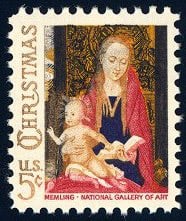
This fifth U.S. Christmas stamp, featuring Madonna and Child, was issued on November 2, 1966. The design on this mint stamp shows a portion of Hans Memling’s 15th century painting „Madonna and Child with Angels.”
Angels and the Nativity have been portrayed on Christmas stamps, but the most popular theme seems to be the Madonna and Child. In fact, every year since 1978 the Postal Service has issued a new Madonna and Child Christmas stamp.
The art for the Madonna and Child stamp is a newly created work, but rather it is a reproduction from some of the most well-known of the world’s masterpieces. For instance, the very first Madonna Christmas stamp, issued in 1966, featured Mary and the infant Jesus from a painting by Flemish Renaissance painter Hans Memling. The stamp did not reproduce the complete painting, but only the detail of Mother and Child. The following year, this same stamp was reissued in a slightly larger size to feature more of the painting.
The original Memling masterpiece hangs in the National Gallery of Art in Washington, D.C., as do most of the originals chosen for the Madonna Christmas stamps. The Art Institute of Chicago, however, provided two Madonna and Child masterpieces: in 1981 a painting by Botticelli and in 1984 one by Italian artist Fra Filippo Lippi.
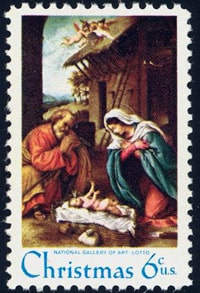
This mint 1970 Christmas stamp was issued on November 5 and features „The Nativity” by Lorenzo Lotto (1480-1556). This painting is located in the National Gallery of Art, Washington, D.C. The stamp measures 40mm x 25.5mm; the above image is an enlargement.
With so many Madonna and Child paintings by great artists over the centuries, selecting just one each year must be difficult. The final choice, however, is made by the U.S. Postal Service Citizen’s Advisory Board which is composed of postal employees, museum art experts (including an authority on art from the National Gallery), and other private citizens. The post office announces its final selection each year in September and the stamp itself goes on sale in October.
The Advisory Board has twice gone outside of the „usual” painted masterpieces: in 1980 and again in 1985. In the first instance, the board chose as the Christmas Madonna stamp, a small portion of the Epiphany window in the Bethlehem Chapel in the Washington National Cathedral. As this cathedral has become known as the „Nation’s Church,” a detail from this window gracing a postage stamp seems appropriate.

The second instance of a nontraditional Madonna was the selection of the Genoa Madonna. This Madonna, from the Detroit Institute of Arts, is a marble sculpture by the Italian sculptor Luca della Robbia. The pure white Madonna pictured against a dark blue background made a sharp contrast to the rich multitude of colors in the many painted masterpieces which have gone before and which have come after.
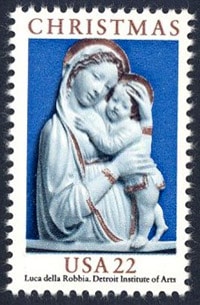
The vivid and varied color of the Madonna stamps is their main appeal to collectors of these beautiful stamps; and their display should be handled so as to enjoy their beauty to its utmost. Serious stamp collectors recommend displaying the stamps in specially designed stamp albums photo albums with soft, plastic pockets. If stamp is attached to a very old envelope, or city of cancellation is important to the collector both should be saved. If the envelope is new no sentimental value to the collector, care cut around the stamp and throw away envelope. Another attractive way to show o rich colors of the Madonna stamps is to frame several, grouping them by artist or by colors the stamps. Either grouping makes a lovely collage which can be displayed all year round.
With the issue of new Christmas stamps every year, this collection is sure to grow don’t expect to grow rich from this collection. Because of the popularity of the stamps an large quantity produced by the post office, the older Madonna Christmas stamps are rarely worth more than three or four times their value. The intangible rewards of such a collection, however, are many; the meaning the subject, the richness of the colors, an history of the paintings all combine to make Christmas Madonna stamps unique and inspiring collectibles.
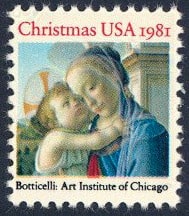
Karen S. Hodge
Reprinted from Christmas Ideals
Vol.48. No.8
Stamps: http://www.collectiblestampsgallery.com
Christmas stamps 2012
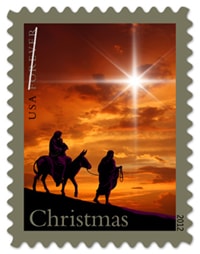
Reenactments and commemorations of this episode are enduring traditions. Medieval mystery plays — dramas based on biblical stories that were performed in towns across Europe from the 14th to 16th centuries — featured the Flight into Egypt as part of their Nativity cycle. Christmas pageants today reenact the Holy Family’s flight, with portrayals ranging from simple children’s plays to elaborate live nativity scenes. Other celebrations include the Feast of the Holy Family, observed by the Roman Catholic Church during the Christmas season, and the Coptic Orthodox Church’s Feast of the Escape of the Holy Family to Egypt, commemorated each year in June.
Source:
http://www.usapostagestamps.com
